Finance Report: Project Feasibility Analysis and Recommendation
VerifiedAdded on 2021/05/31
|7
|1057
|45
Report
AI Summary
This finance report presents a comprehensive analysis of a new project's feasibility, focusing on maximizing shareholder wealth. It includes an examination of incremental cash flows, considering opportunity costs and sunk costs. The report applies various capital budgeting techniques, like NPV, and assesses the project's acceptability. Uncertainty analysis is performed using scenario analysis (optimistic and pessimistic) and sensitivity analysis to evaluate the impact of key variables like cost of capital and sales growth. The analysis reveals a positive base case, with a marginally negative NPV in a pessimistic scenario. Based on the findings, the report recommends proceeding with the project, citing the positive expected NPV and the low likelihood of extreme deviations in key parameters, supported by references to financial management literature.

FINANCE
MEMORANDUM
STUDENT ID:
[Pick the date]
MEMORANDUM
STUDENT ID:
[Pick the date]
Paraphrase This Document
Need a fresh take? Get an instant paraphrase of this document with our AI Paraphraser
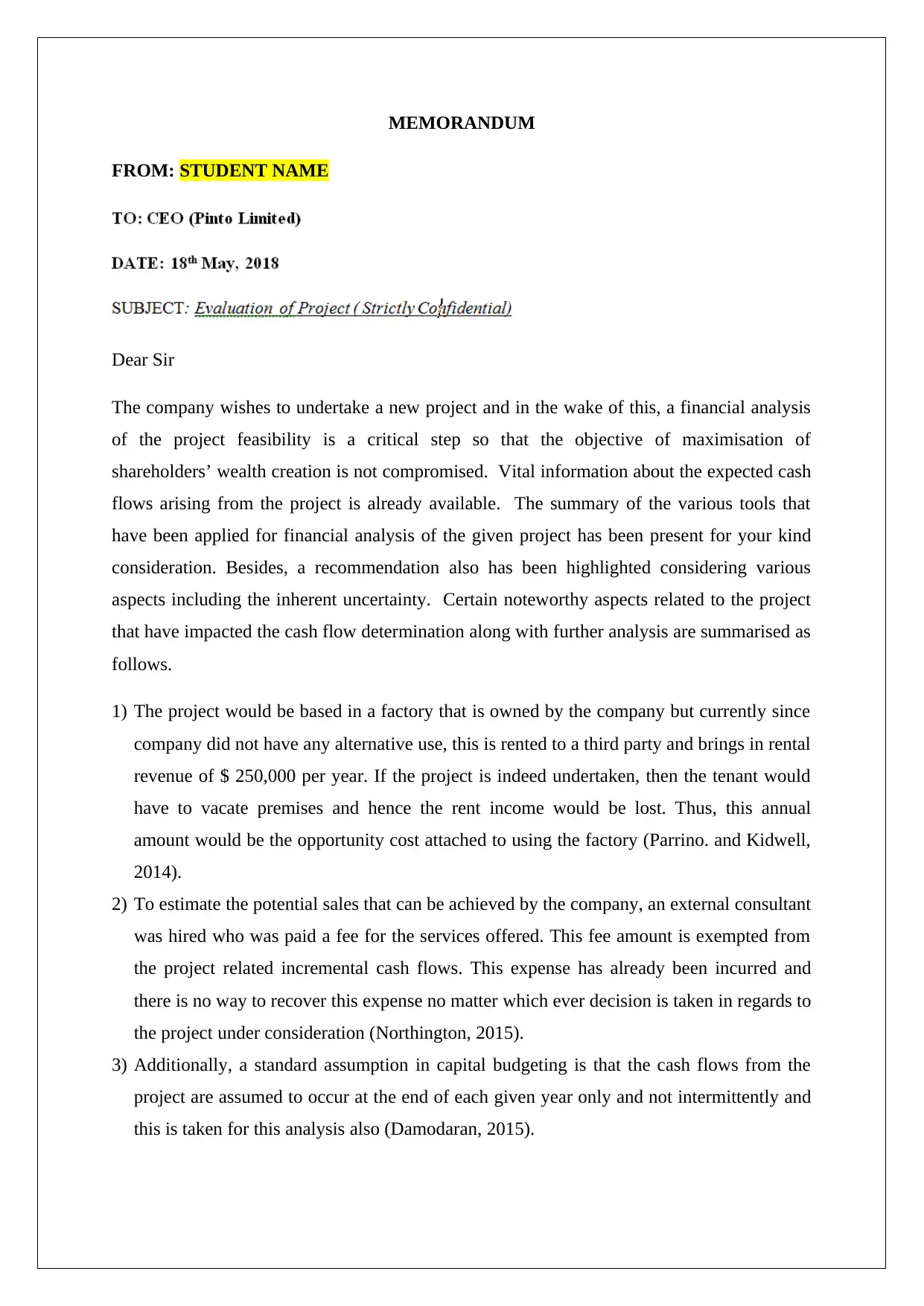
MEMORANDUM
FROM: STUDENT NAME
Dear Sir
The company wishes to undertake a new project and in the wake of this, a financial analysis
of the project feasibility is a critical step so that the objective of maximisation of
shareholders’ wealth creation is not compromised. Vital information about the expected cash
flows arising from the project is already available. The summary of the various tools that
have been applied for financial analysis of the given project has been present for your kind
consideration. Besides, a recommendation also has been highlighted considering various
aspects including the inherent uncertainty. Certain noteworthy aspects related to the project
that have impacted the cash flow determination along with further analysis are summarised as
follows.
1) The project would be based in a factory that is owned by the company but currently since
company did not have any alternative use, this is rented to a third party and brings in rental
revenue of $ 250,000 per year. If the project is indeed undertaken, then the tenant would
have to vacate premises and hence the rent income would be lost. Thus, this annual
amount would be the opportunity cost attached to using the factory (Parrino. and Kidwell,
2014).
2) To estimate the potential sales that can be achieved by the company, an external consultant
was hired who was paid a fee for the services offered. This fee amount is exempted from
the project related incremental cash flows. This expense has already been incurred and
there is no way to recover this expense no matter which ever decision is taken in regards to
the project under consideration (Northington, 2015).
3) Additionally, a standard assumption in capital budgeting is that the cash flows from the
project are assumed to occur at the end of each given year only and not intermittently and
this is taken for this analysis also (Damodaran, 2015).
FROM: STUDENT NAME
Dear Sir
The company wishes to undertake a new project and in the wake of this, a financial analysis
of the project feasibility is a critical step so that the objective of maximisation of
shareholders’ wealth creation is not compromised. Vital information about the expected cash
flows arising from the project is already available. The summary of the various tools that
have been applied for financial analysis of the given project has been present for your kind
consideration. Besides, a recommendation also has been highlighted considering various
aspects including the inherent uncertainty. Certain noteworthy aspects related to the project
that have impacted the cash flow determination along with further analysis are summarised as
follows.
1) The project would be based in a factory that is owned by the company but currently since
company did not have any alternative use, this is rented to a third party and brings in rental
revenue of $ 250,000 per year. If the project is indeed undertaken, then the tenant would
have to vacate premises and hence the rent income would be lost. Thus, this annual
amount would be the opportunity cost attached to using the factory (Parrino. and Kidwell,
2014).
2) To estimate the potential sales that can be achieved by the company, an external consultant
was hired who was paid a fee for the services offered. This fee amount is exempted from
the project related incremental cash flows. This expense has already been incurred and
there is no way to recover this expense no matter which ever decision is taken in regards to
the project under consideration (Northington, 2015).
3) Additionally, a standard assumption in capital budgeting is that the cash flows from the
project are assumed to occur at the end of each given year only and not intermittently and
this is taken for this analysis also (Damodaran, 2015).
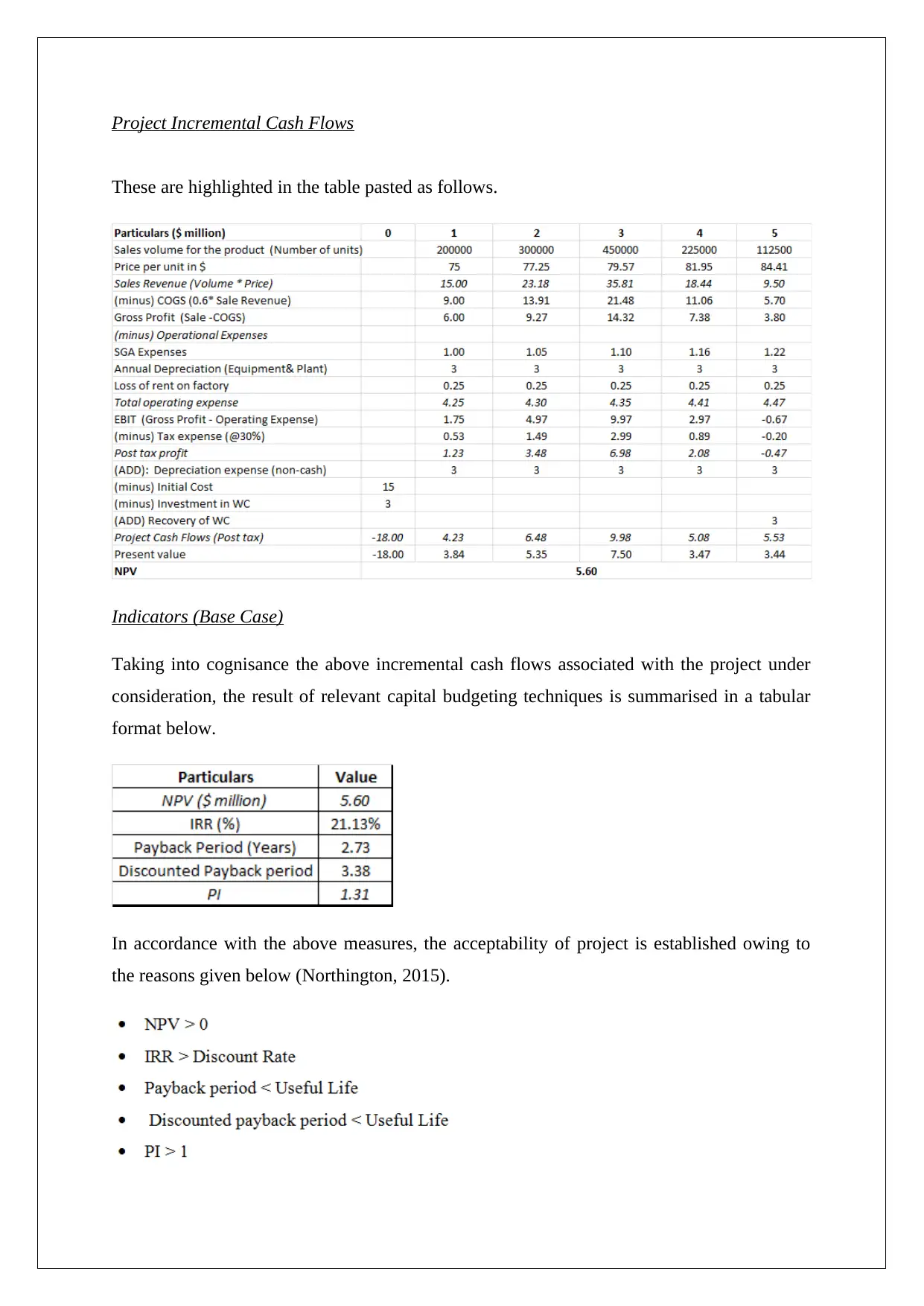
Project Incremental Cash Flows
These are highlighted in the table pasted as follows.
Indicators (Base Case)
Taking into cognisance the above incremental cash flows associated with the project under
consideration, the result of relevant capital budgeting techniques is summarised in a tabular
format below.
In accordance with the above measures, the acceptability of project is established owing to
the reasons given below (Northington, 2015).
These are highlighted in the table pasted as follows.
Indicators (Base Case)
Taking into cognisance the above incremental cash flows associated with the project under
consideration, the result of relevant capital budgeting techniques is summarised in a tabular
format below.
In accordance with the above measures, the acceptability of project is established owing to
the reasons given below (Northington, 2015).
⊘ This is a preview!⊘
Do you want full access?
Subscribe today to unlock all pages.

Trusted by 1+ million students worldwide
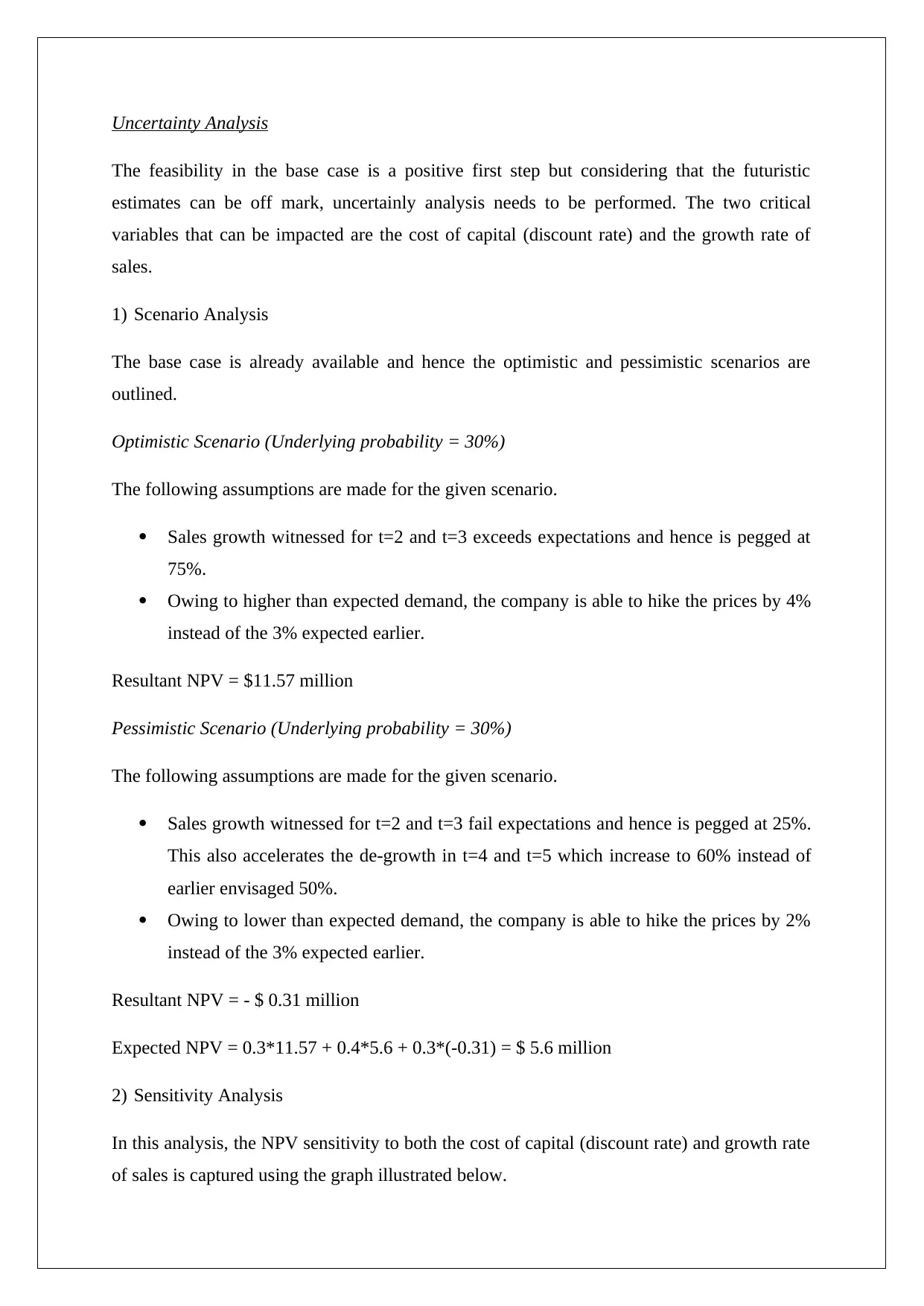
Uncertainty Analysis
The feasibility in the base case is a positive first step but considering that the futuristic
estimates can be off mark, uncertainly analysis needs to be performed. The two critical
variables that can be impacted are the cost of capital (discount rate) and the growth rate of
sales.
1) Scenario Analysis
The base case is already available and hence the optimistic and pessimistic scenarios are
outlined.
Optimistic Scenario (Underlying probability = 30%)
The following assumptions are made for the given scenario.
Sales growth witnessed for t=2 and t=3 exceeds expectations and hence is pegged at
75%.
Owing to higher than expected demand, the company is able to hike the prices by 4%
instead of the 3% expected earlier.
Resultant NPV = $11.57 million
Pessimistic Scenario (Underlying probability = 30%)
The following assumptions are made for the given scenario.
Sales growth witnessed for t=2 and t=3 fail expectations and hence is pegged at 25%.
This also accelerates the de-growth in t=4 and t=5 which increase to 60% instead of
earlier envisaged 50%.
Owing to lower than expected demand, the company is able to hike the prices by 2%
instead of the 3% expected earlier.
Resultant NPV = - $ 0.31 million
Expected NPV = 0.3*11.57 + 0.4*5.6 + 0.3*(-0.31) = $ 5.6 million
2) Sensitivity Analysis
In this analysis, the NPV sensitivity to both the cost of capital (discount rate) and growth rate
of sales is captured using the graph illustrated below.
The feasibility in the base case is a positive first step but considering that the futuristic
estimates can be off mark, uncertainly analysis needs to be performed. The two critical
variables that can be impacted are the cost of capital (discount rate) and the growth rate of
sales.
1) Scenario Analysis
The base case is already available and hence the optimistic and pessimistic scenarios are
outlined.
Optimistic Scenario (Underlying probability = 30%)
The following assumptions are made for the given scenario.
Sales growth witnessed for t=2 and t=3 exceeds expectations and hence is pegged at
75%.
Owing to higher than expected demand, the company is able to hike the prices by 4%
instead of the 3% expected earlier.
Resultant NPV = $11.57 million
Pessimistic Scenario (Underlying probability = 30%)
The following assumptions are made for the given scenario.
Sales growth witnessed for t=2 and t=3 fail expectations and hence is pegged at 25%.
This also accelerates the de-growth in t=4 and t=5 which increase to 60% instead of
earlier envisaged 50%.
Owing to lower than expected demand, the company is able to hike the prices by 2%
instead of the 3% expected earlier.
Resultant NPV = - $ 0.31 million
Expected NPV = 0.3*11.57 + 0.4*5.6 + 0.3*(-0.31) = $ 5.6 million
2) Sensitivity Analysis
In this analysis, the NPV sensitivity to both the cost of capital (discount rate) and growth rate
of sales is captured using the graph illustrated below.
Paraphrase This Document
Need a fresh take? Get an instant paraphrase of this document with our AI Paraphraser
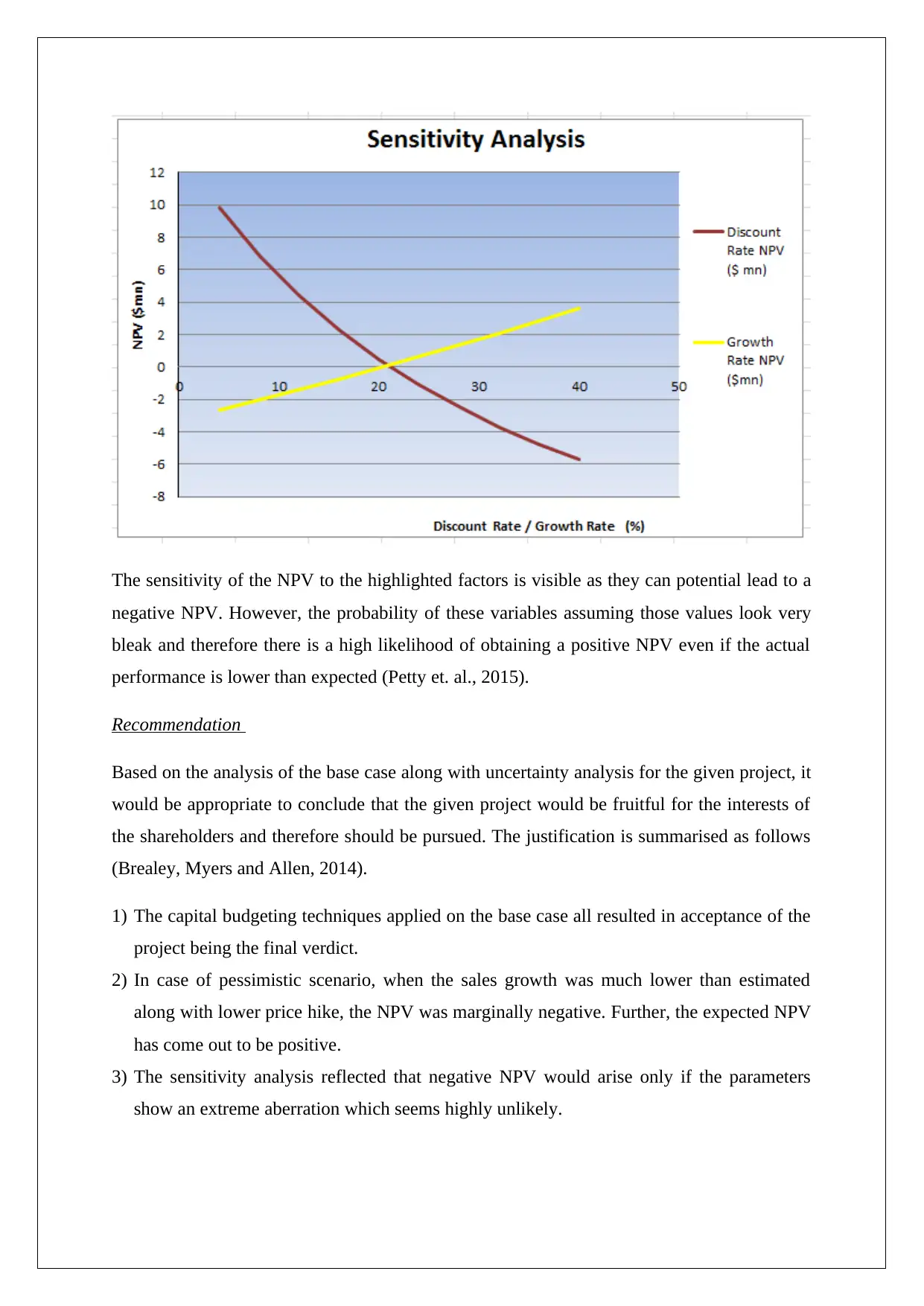
The sensitivity of the NPV to the highlighted factors is visible as they can potential lead to a
negative NPV. However, the probability of these variables assuming those values look very
bleak and therefore there is a high likelihood of obtaining a positive NPV even if the actual
performance is lower than expected (Petty et. al., 2015).
Recommendation
Based on the analysis of the base case along with uncertainty analysis for the given project, it
would be appropriate to conclude that the given project would be fruitful for the interests of
the shareholders and therefore should be pursued. The justification is summarised as follows
(Brealey, Myers and Allen, 2014).
1) The capital budgeting techniques applied on the base case all resulted in acceptance of the
project being the final verdict.
2) In case of pessimistic scenario, when the sales growth was much lower than estimated
along with lower price hike, the NPV was marginally negative. Further, the expected NPV
has come out to be positive.
3) The sensitivity analysis reflected that negative NPV would arise only if the parameters
show an extreme aberration which seems highly unlikely.
negative NPV. However, the probability of these variables assuming those values look very
bleak and therefore there is a high likelihood of obtaining a positive NPV even if the actual
performance is lower than expected (Petty et. al., 2015).
Recommendation
Based on the analysis of the base case along with uncertainty analysis for the given project, it
would be appropriate to conclude that the given project would be fruitful for the interests of
the shareholders and therefore should be pursued. The justification is summarised as follows
(Brealey, Myers and Allen, 2014).
1) The capital budgeting techniques applied on the base case all resulted in acceptance of the
project being the final verdict.
2) In case of pessimistic scenario, when the sales growth was much lower than estimated
along with lower price hike, the NPV was marginally negative. Further, the expected NPV
has come out to be positive.
3) The sensitivity analysis reflected that negative NPV would arise only if the parameters
show an extreme aberration which seems highly unlikely.

.Yours Sincerely
STUDENT NAME
STUDENT NAME
⊘ This is a preview!⊘
Do you want full access?
Subscribe today to unlock all pages.

Trusted by 1+ million students worldwide
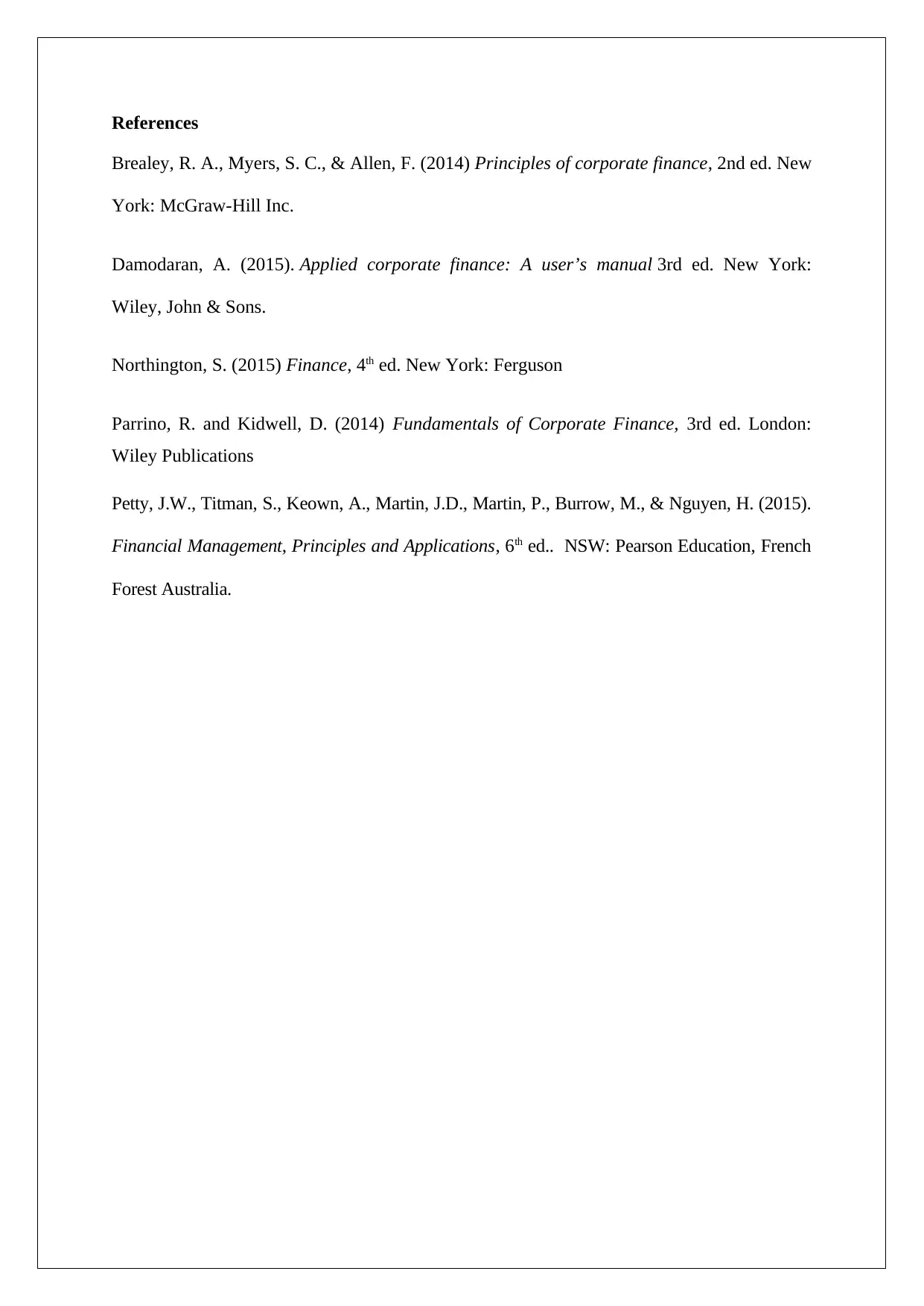
References
Brealey, R. A., Myers, S. C., & Allen, F. (2014) Principles of corporate finance, 2nd ed. New
York: McGraw-Hill Inc.
Damodaran, A. (2015). Applied corporate finance: A user’s manual 3rd ed. New York:
Wiley, John & Sons.
Northington, S. (2015) Finance, 4th ed. New York: Ferguson
Parrino, R. and Kidwell, D. (2014) Fundamentals of Corporate Finance, 3rd ed. London:
Wiley Publications
Petty, J.W., Titman, S., Keown, A., Martin, J.D., Martin, P., Burrow, M., & Nguyen, H. (2015).
Financial Management, Principles and Applications, 6th ed.. NSW: Pearson Education, French
Forest Australia.
Brealey, R. A., Myers, S. C., & Allen, F. (2014) Principles of corporate finance, 2nd ed. New
York: McGraw-Hill Inc.
Damodaran, A. (2015). Applied corporate finance: A user’s manual 3rd ed. New York:
Wiley, John & Sons.
Northington, S. (2015) Finance, 4th ed. New York: Ferguson
Parrino, R. and Kidwell, D. (2014) Fundamentals of Corporate Finance, 3rd ed. London:
Wiley Publications
Petty, J.W., Titman, S., Keown, A., Martin, J.D., Martin, P., Burrow, M., & Nguyen, H. (2015).
Financial Management, Principles and Applications, 6th ed.. NSW: Pearson Education, French
Forest Australia.
1 out of 7
Related Documents
Your All-in-One AI-Powered Toolkit for Academic Success.
+13062052269
info@desklib.com
Available 24*7 on WhatsApp / Email
![[object Object]](/_next/static/media/star-bottom.7253800d.svg)
Unlock your academic potential
Copyright © 2020–2025 A2Z Services. All Rights Reserved. Developed and managed by ZUCOL.





